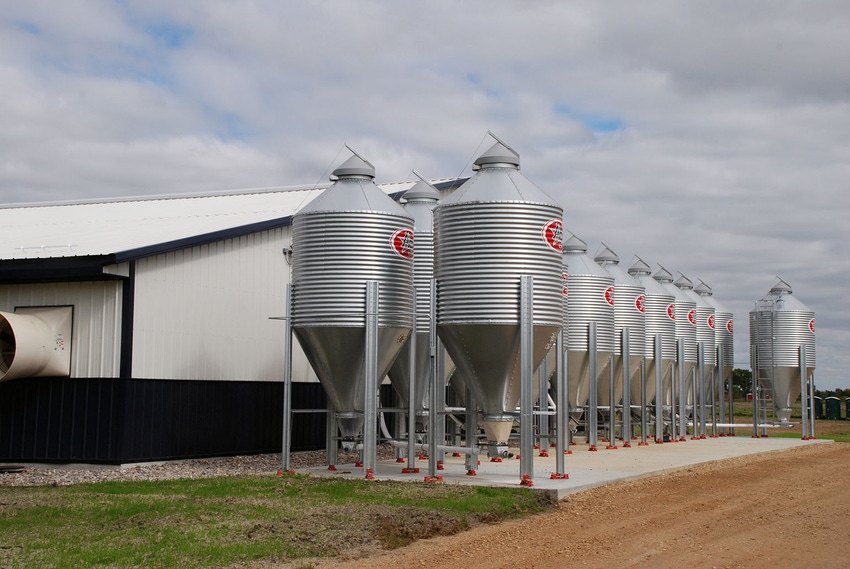SDSU unveils Pork Cares Farm Impact Report 2022
Most of the carbon footprint was attributed to manure and feed; both wean-to-finish facilities use cup waterers which helps to reduce water usage.
May 18, 2023

A Pork Cares Farm Impact Report details the efforts and practices employed by pork producers to promote sustainable agriculture. The report includes information on the farm's environmental impact, social responsibility and economic viability. The Pork Cares Impact Report is a valuable tool for producers to demonstrate their commitment to sustainability and transparency to consumers and stakeholders.
In terms of environmental impact, a Pork Cares Farm Impact Report details the efforts to conserve natural resources such as water and soil. For example, in the corresponding Sustainable Continuous Improvement Plan, producers are encouraged to install water meters to monitor water usage for indications of water leaks and to ensure optimal water flow rate (i.e. 1-2 cups per minute for weaned pigs and 4 cup/min for gestation and farrowing) to reduce water wastage. The SCIP also provides information about in-field practices as a valuable tool for pork producers who want to improve their soil sustainability through best management practices such as reduced and no till farming and the use of cover crops. The best management practices are based on scientific research and are designed to help producers improve their sustainability performance.
In terms of social responsibility, the report discusses the farm's efforts to promote animal well-being, support local communities, and provide leadership opportunities for employees.
Finally, in terms of economic viability, the report discusses the farm's financial performance and how it balances profitability with sustainability.
The Pork Cares Farm Impact Report for the South Dakota State University Swine Education and Research Facility farrow-to-finish and wean-to-finish barns was recently prepared. The data was provided to Sustainable Environmental Consultants within the National Pork Board funded initiative to collect data from individual producers and prepare individual Pork Cares Impact Reports. The initial information gathering session was completed with a one-hour call and additional information was provided via email.
In 2022:
Each wean-to-finish barn produced 2,400 market pigs
The Sow Teaching and Research complex housed 150 sows
Water usage was 133 gallons per head
Energy usage was 65 kilowatt hours per head
The 416,000 gallons of manure was spread across five fields:
83% of the 127 acres received liquid manure fertilizer
The average rate was 3,970 gallons/acre
The soil conditioning index was positive
Net greenhouse gas emissions were 0.41 T CO2e/acre
Soil carbon sequestered was 0.14 T/acre
Soil erosion rate was 0.41 T/acre
Compared to conventional tillage, no cover crop production:
74 fewer tons of CO2e were produced
20 tons of soil carbon was sequestered
2 tons of soil was saved
The carbon footprints according to the National Pork Board calculator were 602 and 725 lbs CO2e per market pig produced from the on-site and off-site wean-to-finish barns, respectively. Most of the carbon footprint (>75%) was attributed to manure and feed with contributions from energy, fuel, water, and mortality disposal. The manure being pumped from the on-site twice per year compared to once per year at the off-site reduced the impact of manure on the overall carbon footprint. Both of the wean-to-finish facilities use cup waterers which helps to reduce water usage.
Most pork producers are already engaged in precision nutrition, proper manure and water management, and the use of energy efficient light bulbs to reduce their carbon footprint. Pork producers can take further steps to reduce their contribution to carbon footprint and improve the sustainability of their operations. Here are some examples of practices that can help:
Energy Efficiency: By implementing energy-efficient practices on their farms, pork producers can reduce their carbon footprint. This can include using renewable energy sources like solar or wind power, using more efficient equipment and lighting, and optimizing ventilation and heating systems.
Nutrient Management: Proper management of manure and other agricultural wastes can reduce greenhouse gas emissions from pork production. By using manure as a fertilizer instead of synthetic fertilizers, pork producers can reduce the carbon footprint associated with the production and transport of these inputs.
Feed Management: The type and amount of feed given to pigs can also impact their carbon footprint. By optimizing feed rations to reduce waste and using sustainable feed ingredients, such as soybean meal or distiller's grains, pork producers can reduce the carbon footprint of their operations.
Animal Health and Welfare: Healthy and well-cared-for pigs are more efficient in converting feed into meat, which can reduce the carbon footprint of pork production. By implementing practices that improve pig health and well-being, such as providing biosecure housing and proper ventilation, producers can reduce the environmental impact of their operations.
Carbon Sequestration: Carbon sequestration is the process of capturing and storing carbon dioxide from the atmosphere. Pork producers can contribute to carbon sequestration by implementing practices such as planting trees or using cover crops, which can help capture and store carbon in the soil.
Overall, the Pork Cares Farm Impact Reports highlight the commitment of pork producers to the We Care Ethical Principles of Animal Well-being, Our Communities, Our People and the Environment. Individual producers can sign up here to participate and receive their personalized report. Some of the many ways that pork producers can reduce their carbon footprint and improve the sustainability of their operations will be provided in the Sustainable Continuous Improvement Plan. By implementing these practices, they can demonstrate their commitment to sustainability and reduce their environmental impact.
You May Also Like



